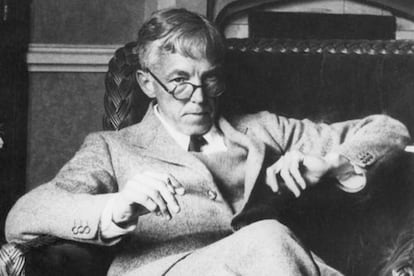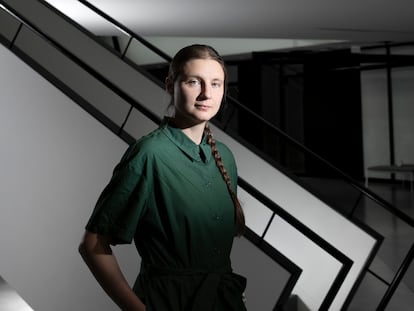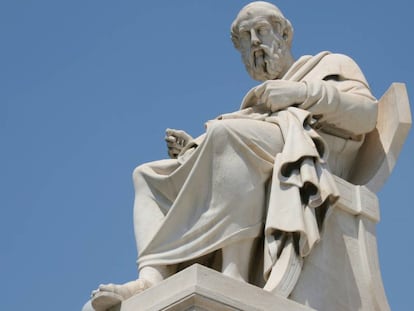G.H. Hardy: Remembering Britain’s eccentric and brilliant mathematician
The researcher, who died 75 years ago, collaborated with another self-taught genius, Srinivasan Ramanujan, whose work he helped promote

Godfrey Harold Hardy, who died 75 years ago on December 1, was one of the most important British mathematicians of the last century. Between the two world wars, he lived in the universe of Cambridge and Oxford universities, along with other leading figures including Bertrand Russell and John Maynard Keynes. His publications with John Edensor Littlewood are regarded as the epitome of a fruitful mathematical collaboration. The quality of their work led Harald Bohr to say, “There are three great English mathematicians: Hardy, Littlewood and Hardy-Littlewood.”
His other celebrated collaborator was the self-taught mathematical genius Srinivasa Ramanujan, whom he discovered and helped promote. Hardy chronicled his fascinating scientific and life adventures in the biography he wrote after Ramanujan’s untimely death. In it, he wrote, “my association with him is the one romantic incident in my life.”
With his two collaborators, he developed the so-called circle method, a number theory instrument that led him to make important discoveries. Among them are a formula to express the number of partitions of a positive integer as a sum of others; significant advances in problems on the representation of integers as sums of powers; and the ternary Goldbach conjecture which states that every odd integer greater than five can be expressed as the sum of three primes.
In addition to number theory, he also focused on researching harmonic analysis. He witnessed the paradigm shift brought about by Henri Lebesgue’s measure theory and the emergence of functional analysis, when the emphasis shifted from the study of properties of so-called special functions to that of the classes or spaces of functions. That shift was driven by the emerging mathematical foundation for quantum mechanics, as well as by the resolution of the equations in partial derivatives of other more classical theories of physics.
Hardy lived his life among theorems, mainly at Trinity College, in Cambridge University. His body of work is collected in eight volumes, making up about 800 pages. In addition, he was the author of several monographs, most notably Introduction to Number Theory, written in collaboration with Edward Wright, which is still used as a textbook for university courses.
His work A Mathematician’s Apology deserves a special mention. In the essay, written when he was 62 years old, he describes the nature of mathematical research and its relationship with artistic creation. The work oozes with the bitterness of someone who, as he admits, has stripped by age of the energy necessary for the deep thought that mathematical research requires.
The precision and beauty of his prose stand out throughout his work, as well as the forcefulness of his opinions and aphorisms: “There is no permanent place in the world for ugly mathematics,” he wrote. “It is not worth an intelligent man’s time to be in the majority. By definition, there are already enough people to do that.”
His comments on applied science now seem profoundly wrong, but one must take into account the context, his pacifist ideals and the tough times through which he lived. He was known for his eccentric character: he liked wearing silk shirts; he hated seeing his own reflection, so he covered all the mirrors in his home.
An avowed atheist, he claimed that the gods were his personal enemies. When he sailed to visit Harald Bohr in Copenhagen, he fantasized about sending cards to friends claiming to have solved the Riemann Hypothesis. He would thereby avert the danger of shipwreck, he said, since the gods would not allow Hardy to go down in history having achieved the answer to such an elusive enigma.
The Riemann Hypothesis is considered by many as the Holy Grail of mathematics. It was the problem that Hardy most wanted to solve. He managed to demonstrate the existence of infinitely many zeros on that line, which opened the door for others. But the Riemann Hypothesis is still waiting for an answer.
Tu suscripción se está usando en otro dispositivo
¿Quieres añadir otro usuario a tu suscripción?
Si continúas leyendo en este dispositivo, no se podrá leer en el otro.
FlechaTu suscripción se está usando en otro dispositivo y solo puedes acceder a EL PAÍS desde un dispositivo a la vez.
Si quieres compartir tu cuenta, cambia tu suscripción a la modalidad Premium, así podrás añadir otro usuario. Cada uno accederá con su propia cuenta de email, lo que os permitirá personalizar vuestra experiencia en EL PAÍS.
¿Tienes una suscripción de empresa? Accede aquí para contratar más cuentas.
En el caso de no saber quién está usando tu cuenta, te recomendamos cambiar tu contraseña aquí.
Si decides continuar compartiendo tu cuenta, este mensaje se mostrará en tu dispositivo y en el de la otra persona que está usando tu cuenta de forma indefinida, afectando a tu experiencia de lectura. Puedes consultar aquí los términos y condiciones de la suscripción digital.










































